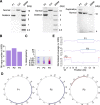Accurate mapping of mitochondrial DNA deletions and duplications using deep sequencing
- PMID: 33315859
- PMCID: PMC7769605
- DOI: 10.1371/journal.pgen.1009242
Accurate mapping of mitochondrial DNA deletions and duplications using deep sequencing
Abstract
Deletions and duplications in mitochondrial DNA (mtDNA) cause mitochondrial disease and accumulate in conditions such as cancer and age-related disorders, but validated high-throughput methodology that can readily detect and discriminate between these two types of events is lacking. Here we establish a computational method, MitoSAlt, for accurate identification, quantification and visualization of mtDNA deletions and duplications from genomic sequencing data. Our method was tested on simulated sequencing reads and human patient samples with single deletions and duplications to verify its accuracy. Application to mouse models of mtDNA maintenance disease demonstrated the ability to detect deletions and duplications even at low levels of heteroplasmy.
Conflict of interest statement
The authors have declared that no competing interests exist.
Figures




References
-
- Goffart S, Cooper HM, Tyynismaa H, Wanrooij S, Suomalainen A, Spelbrink JN. Twinkle mutations associated with autosomal dominant progressive external ophthalmoplegia lead to impaired helicase function and in vivo mtDNA replication stalling. Hum Mol Genet. 2009;18(2):328–40. Epub 2008/10/31. 10.1093/hmg/ddn359 - DOI - PMC - PubMed
Publication types
MeSH terms
Substances
LinkOut - more resources
Full Text Sources
Molecular Biology Databases

